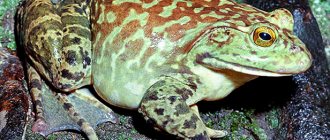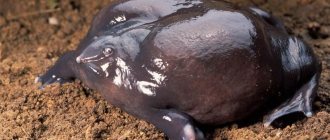Description
The amphibian's homeland is Africa, its range has spread to Europe and the American continent. The frog is called a spur frog because of the claws (spurs) on its hind legs. Claws up to 3 mm in size are involved in the process of swimming and hunting. The hind legs have webs. Forelegs with long, unwebbed toes. The body length of an individual in nature is up to 9 cm; at home, the clawed amphibian grows larger. The muzzle is short and rounded. The amphibian breathes air and has a good sense of smell. Color ranges from light to dark brown. Sometimes there are fuzzy patterns on the body. Local residents eat clawed amphibians.
Character
Spur amphibians are predators that do not like their neighbors. Nervous, if the animal is frightened, it begins to rush around the aquarium.
Lifespan
Amphibians live 10–15 years, with the exception of albinos, which live up to 10 years.
Types of aquarium frogs
After the first species of clawed frog was described, scientists discovered about 18 of its species . Of these, only 5 species turned out to be suitable for keeping in aquariums.
Shportsevaya (xenopus)
Xenopus, or clawed water frog, has lived in South Africa since ancient times. Thanks to travelers, today it can be found in the waters of Chile, California and the UK.
The upper part of the body is colored greenish-olive and dark brown, complemented by dark spots. The abdomen is white or with brown spots.
Of particular interest to aquarists is the artificially bred albino clawed frog.
Large, up to 15 cm, it attracts attention with its pinkish-white color. The lifespan of a hybrid is shorter than that of an ordinary frog.
Attention! Albinos suffer from obesity.
African dwarf (Hymenochirus)
All of Equatorial Africa is where Hymenochirus lives in nature. It has firmly populated the warm waters of the Congo, Nigeria, Cameroon and Zaire. This species has an elongated body up to 3–4 cm and thin legs.
The muzzle is pointed, eyes without eyelids, located on the sides. Böttger's clawbearer is painted in gray-brown and dark gray tones.
The abdomen has lighter shades. Feels good in captivity and reproduces successfully.
American pipa
The original shape and impressive size distinguish the American pipa from its smaller relatives. The length of its strangely flattened body can reach 20 cm.
The square-shaped pipa is covered with wrinkled skin, colored in dull gray-brown tones.
It also has one more feature that does not bring joy to its owners: the frog emits the smell of hydrogen sulfide.
Toadstools
The small toad, up to 6 cm, is very beautiful. She has lumpy skin along her back, the main tone of which is brown, and dark green spots are scattered over it.
And as a bright touch to the image - an orange or red belly with randomly outlined spots of black and blue.
The frog's large eyes have triangular pupils. Due to the unique structure of the tongue, which is attached with the lower part to the oral cavity, fire-bellied toads cannot croak.
However, they are not dumb. The sound they make is reminiscent of a drawn-out “oo-oo-oo”.
Content
Claw frogs are easy to keep and care for and are suitable for beginners. Provide animals with clean and cool water.
Aquarium
The volume of the aquarium for one clawed frog is 30–40 liters. This species lives submerged in water, so the aquarium must be filled completely with water. No land islands required. The clawed amphibian spends most of its time at the bottom, so give preference to a wide rectangular aquarium with a lid. Place a special thermometer in the water to know the exact temperature.
Compatibility with other aquarium inhabitants
Both experts and the owners of the original inhabitants believe that the clawed frog does not need neighbors .
Small species of fish will become food for her, and proximity to large predators will lead to equal stress for all inhabitants of the aquarium.
Sharp jerks of amphibians can frighten the same cichlids, and they will respond with an attack. Both sides will suffer, and as a result, you will not get any pleasure from keeping them together.
Reproduction
In an aquarium, frogs breed once a year. Encourage animals to breed by replacing 30% of the water. Shade the aquarium and temporarily turn off the filter. Maintain the temperature at 22–25 degrees. During the day, the female lays about 200 eggs. After a few days, the offspring appears. To increase survival rate, transfer the parents to another aquarium. The emerging tadpoles eat on the 7th day of life. Feed them chopped adult food. Provide the offspring with stable water parameters and volume at the rate of 1 liter per 10 individuals. The transformation into frogs is completed after 2 months.
Care
It seems to be a simple creation, but it has its own special requirements for content.
Frogs are not picky when choosing food , they do not need aeration, but caring for them has its own difficulties.
Feeding
Frogs are omnivores, moreover, they are all terrible gluttons. In a small space in a home aquarium, where they lack freedom of movement, you need to carefully monitor the dosage and caloric content of food.
View this post on Instagram
Publication from Vlad and Olga from Riga (@vlad_aquaman_tehnik) Sep 9, 2019 at 10:53 PDT
The diet of amphibians includes:
- bloodworm;
- fresh fish;
- shrimp meat;
- beef and beef heart.
Some frog owners pamper their pets with small species of aquarium fish. is also suitable for them , for example, Tetra ReptoFrog Granules .
Young individuals are given food every day, adults only need 2-3 times a week.
Diseases
Pets get sick when the temperature is inappropriate, the water is excessively polluted, or parasites are introduced by live food. Animals are susceptible to:
- Infection with nematodes. The skin takes on a grayish tint and flakes off. The amphibian loses its appetite and loses weight. Upon closer examination, small worms are visible. Treated with most parasite medications, such as Panacur (for lung nematodes) or piperazine (for intestinal nematodes).
- Fungal infections. On injured areas, growths similar to cotton wool form. Treat clawed frogs with salt baths and solutions.
- Sepsis. The disease is also called “red leg”. The animal loses its appetite, the abdomen becomes reddish, and the skin turns pale. In advanced stages, the paws swell and ulcers appear. Baths with sulfadimidine (15 ml per 10 liters of water) are effective against infection.
- Dropsy. The clawed frog's body swells. Remove the sick individual and add Gentomycin to the water.
Cleaning
You should change the water (at least 20% of the total volume), as well as clean the aquarium, weekly.
The water used for replacement should stand for 2-3 days. You can add a special conditioner to it, which will quickly clean tap water of chlorine and make it suitable for frogs to live in.
The aquarium needs to be cleaned every week.
Carefully remove waste from the filter, glass and soil.
Do not use detergents to wash the soil and decorations.
Photo gallery
Determination of gender
Accurate determination of the sex of the clawed frog is possible only from 7 months. Females, unlike males, are larger in size and have a calm character. On the back of the body there is an ovipositor, similar to a tail. The male is thinner, moves a lot, and during spawning makes sounds like chirping or ticking.
Males are usually 20% smaller than females, with thin bodies and legs
Courtship ritual
The male's mating call is very melodic, consisting of alternating long and short trills. Hearing this call, the female answers the male. This is one of the few animals in which the female answers the male's call! During mating, the male grasps the female from behind. An hour later, egg laying begins.
Albino frog
Reviews
These unusual pets will decorate your aquarium.
They are emotional and sensitive. The clawed frog is fun to watch and care for. It's fun to hand feed her. Over time, pets will even be able to recognize their owner by voice. Have you tried keeping a clawed frog in an aquarium? Would you like to? Share your experiences and opinions in the comments.
Tips before buying an amphibian
Before you get an African clawed frog, you need to know that its compatibility with other inhabitants of the aquarium is very low. And if the owner wants to create an amazing corner of the underwater world, where there are various ornamental animals, then such an amphibian will not be able to coexist with them.
Before purchasing clawed frogs, you should study information about their nutrition, housing and health maintenance
The most important thing is to purchase an aquarium of a suitable size. To do this, you need to decide on the number of pets that will live in it.
The first frog can be taken for free, “in good hands” from those owners who have not coped with its maintenance.
If you hand feed such a frog, it will very soon cease to be afraid of communicating with its owner.
Soil and decor
The soil in the aquarium must be large so that the frog does not swallow it. You can use anything as decoration. The main thing is that it does not have sharp corners that could injure the pet and is heavy so that he cannot move it from its place. The decorations used are placed in different corners so that the frog has room to jump. If you provide shelters, they should be wide enough so that an adult frog can easily climb in and out of it.
As for plants, these can only be hard-leaved anubias. Ordinary plants will not take root in coarse soil, and the frog will simply ruin them with its claws and teeth. If you still want to try it, then plant the plants in pots.
For the gray clawed frog, any lighting will do. But bright lighting is not suitable for albinos, as it can lead to blindness.
Behavioral characteristics of pets
Frogs are among the most ancient species of amphibians, appearing on the planet long before dinosaurs, so watching them is no less interesting than colorful aquarium fish.
These creatures are not primitive. They have a good memory and are able to remember the faces of their owners and even treat people differently. Frogs and toads, if given food on a schedule, will approach the place where they can get food at the right time.
Species affiliation influences the behavior of these animals. Large frogs are often aggressive, digging through and tearing up algae, moving decor, etc.
Such individuals have difficulty getting along with fish and other inhabitants of the aquarium, and may even perceive their “neighbors” as food. It is better to keep them in a separate aquaterrarium only with their relatives.
Dwarf species have a more docile character. They rarely damage decor and plants and pollute their habitat less intensively.
These creatures are slow, so they can often be seen sitting on the bottom of an aquarium or on a piece of land. Attempts to hide in dense thickets of aquatic plants are the norm for them.
Some pet frogs can make quite loud noises, more often at night. This happens not only during the breeding season.
With the help of piercing sounds, individuals living in the tank maintain social contacts.
Behavior
The clawed frog is distinguished by its arrogant, active and shameless behavior. These animals devour all living things that can fit in their mouths, constantly dig up and tear aquarium plants, raise mud, move stones, snags, decorations, and constantly dig the soil.
It's interesting to watch them, they don't hide. Their faces are incredibly expressive, and they love to take original poses and hang picturesquely in the water column. The animals are impressionable, but quickly get used to the owner and recognize him.
Sexual dimorphism
Sexual dimorphism is weakly expressed, the color is the same, but when compared, the females are slightly larger than the males. The easiest way to determine the sex of a frog is during the mating season - males sing loudly during this period, and black stripes appear on their front legs on the sides of the toes and along the paw to the armpit area, these are the so-called “mating brushes.”
The behavior of clawed frogs is very interesting, they are active, social, communicate with people with interest and even recognize the person who feeds them most often, and get used to taking food from hands.











